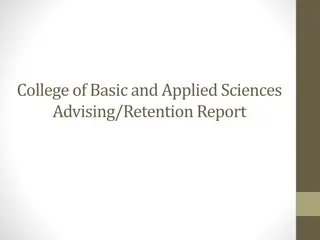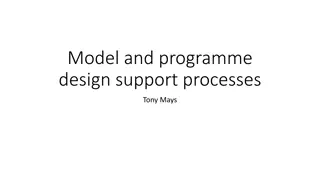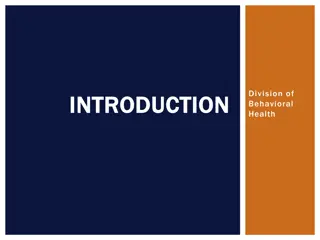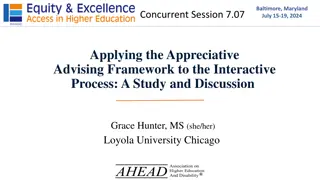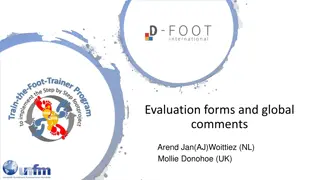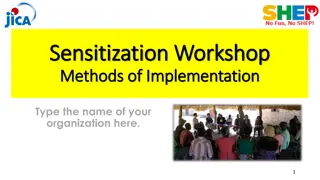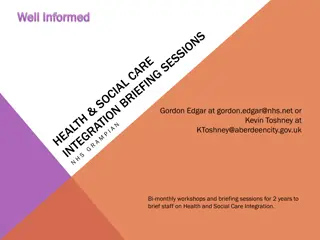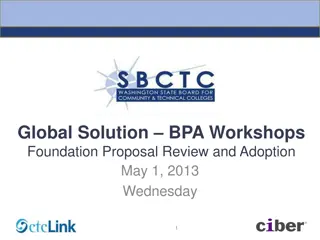Enhancing Advising Process for Specified Illness Cover Workshops
Guidance on developing a structured process for advising on Specified Illness Cover, addressing challenges faced by financial brokers in selling and positioning the product. Workshop objectives include client engagement, research, explaining benefits, and product understanding. The content covers agenda, challenges, professional opinion, and upcoming reports related to Specified Illness Cover workshops.
Download Presentation

Please find below an Image/Link to download the presentation.
The content on the website is provided AS IS for your information and personal use only. It may not be sold, licensed, or shared on other websites without obtaining consent from the author. Download presentation by click this link. If you encounter any issues during the download, it is possible that the publisher has removed the file from their server.
E N D
Presentation Transcript
Brokers Ireland & ClearChoice Specified Illness Cover Workshop April 2018 1
Specified Illness Cover Workshops & Guidance Paper | The Why! 100 Illnesses! Yes and Partial Older SI contracts versus new SI contracts Level of detail is frightening! Fact-finding process Selling on the number of illnesses a Life Company may offer Compliance issues Pricing environment 2
Specified Illness Cover Workshops & Guidance Paper | The Why! Professional Opinion/House View Protecting your advice process utilising ClearChoice Using a client s personal experiences | Rheumatoid Arthritis example Upcoming ClearChoice report around SIC Legal opinion states that every adviser offering Specified Illness cover advice must have a reasonable working knowledge of SIC Issues around Claim Statistics from various Life Companies Commonality needed in their representation for Financial Brokers 3
Specified Illness Cover Workshop| Agenda 9.30 a. m Factfinding & Needs Analysis 9.45 a .m Researching Specified Illness Cover 10.10 a.m What to consider when advising 10.20 a.m Claims information and analysis criteria 11.00 a.m Specified Illness Cover & Income Protection 11.10 a.m Future Trends & issues 4
Specified Illness Cover | The Challenges Financial Brokers are; Apprehensive about selling Specified Illness Cover Have had claims/potential advice liability issues Have had claims rejected due to various issues including explanation and limitations of Specified Illness Cover Have stopped selling Specified Illness Cover altogether Are not comfortable positioning the product & need a process/structure Know they are not medical professionals, yet there are now 100 Illness definitions* as of March 2018 across the 6 providers 5
Workshop Objectives The objectives are to give you guidance on; Developing a structured process for advising on Specified Illness Cover with a client Context of the product and what its purpose is for a client The factors to consider within the fact-finding & recommendation process including; Client engagement & research How to explain the value & benefits Premiums & Sums Insured Product Structure How to better interpret Specified Illness Cover terminology & definitions Understanding claims statistics & probabilities with the information available International experiences & trends 6
Specified Illness Cover | An introduction Specified Illness Cover has greatly evolved since its introduction to the Irish Protection market in the late 1980 s. Specified Illness Cover was conceived by a Dr. Marius Bernard in the early 1980 s as a surgeon in South Africa, whereby he saw the damage that financial hardship could inflict on a patient that survives. In 1983 the first three illnesses were; Cancer Heart Attack Stroke http://www.thejournal.ie/cancer-rates-ireland- 3682415-Nov2017/ 7
Specified Illness Cover | The concept Specified Illness Cover is the only Protection product that is driven by cause, not effect. I.E the cause of a Life death claim or Income Protection claim is focused on the outcome, not the cause. Whereas it is the opposite with Specified Illness Cover. It is important to remember this through the Specified Illness Cover recommendation process. 8
Specified Illness Cover | The Policies! When advising or discussing Specified Illness Cover, it is common that there be a heavy focus on the illness definitions and what these are, including how many illnesses are covered. Illness definitions and their payable amount are not the only aspect of a Specified Illness Cover policy that must be addressed when advising. Features such as the below are all key to a recommendation for a client; Term Conversion options Maximum ages of entry of a contract What is the maximum age a client can convert a policy Ancillary benefits such as Childrens benefits 9
Policy Description Specified Illness Cover As noted above, the presentation of advice is crucial with respect to Specified Illness Cover. It is imperative that the word Specified is utilised in any materials or content around this product and its recommendations. There are variations in this industry in what it is labelled, these include; Serious Illness Cover Critical Illness Cover Trauma Cover Ill Health Cover These descriptions are misleading to a client. These terms infer a broad meaning, i.e that once seriously ill that there will be a payment on a policy should the client attempt to claim. 10
Legal Precedents for adviser descriptions of Specified Illness Cover Geoghegan V Financial Services Ombudsman(FSO) In 2008 the appelants husband was diagnosed as suffering from cardiomyopathy, they subsequently submitted a claim on the Critical Illness Benefit policy in 2009. Upon application, the claim was declined by the insurer. This denial of claim was predicated on the basis that their definition of heart attack on the policy did not included cardiomyopathy. The couple claimed that they believed that this policy would cover them for all manner of serious illnesses under the policy, and not specific definitions. The couple claimed that they were in essence mis-sold this policy at the point of sale and that they were not informed that specific illness criteria applied to any illness such as heart attack or cancer. 11
Issues around the Presentation of Specified Illness Cover Financial Brokers are often presented with comparative analysis of what each companies will and will not covered across the 6 Life Offices and the relevant Specified Illness Cover definition. It is often presented in a simplified format of Yes or No or Partial This is misleading & must not be presented to a client in isolation. A simplified Yes to a Heart Attack definition is not a Yes, it is a Yes with the Specified Illness definition criteria with each respective Life Office that must be presented to a client at some stage for their own consumption. 12
Section 1.Factfinding & Needs Analysis | Protection Section Specified Illness Cover is a living Life benefit that is sometimes stated as the alternative to Income Protection. This is not the case and it can be complementary to Income Protection, as well as an excellent solution in itself in covering a client for illness/injury. There is no set specific calculator/recommendation level for a client for Specified Illness Cover currently in place in the Life & Pensions industry. A frequent rule of thumb for the calculation of a Specified Illness Cover sum insured amount is 2 x times a persons salary i.e to cover them if out of work for up to 2 years. 13
Section 1.Factfinding & Needs Analysis | Protection Section This, when considering taxation at current levels, would work out at almost 4 x times net salary or 4 years covered. When advising, this may be off-putting to a client when recommending Specified Illness Cover as; It may become too expensive a premium at this sum assured of 4 years net salary 14
Section 1.Factfinding & Needs Analysis | Protection Section Partial Payment Issue The limitations of Partial Payments, capped at 15,000 to 20,000, should also be considered when recommending a lump sum insured. The Partial Payments that have come on stream in recent times are not obscure or unlikely medical events. In recent years there has been a proliferation of listed claim definitions that are categorised as Partial Payments . These potential claims are illnesses/injury that are related to full payments in many instances, but are designed to be for less severe claims The Partial Payments are designed for areas of illness such as Carcinoma in Situs ( Cancer that has developed in one specific part of the body), Angioplasty, one & two vessels etc 15
Section 1.Factfinding & Needs Analysis | Protection Section Partial Payment Issue These developments in partial payments must also be taken into account when assessing your recommendation lump sum insured amount for a client i.e. a person taking out 175,000 when there is an increasing likelihood that any claim they make may only be a partial, which is capped at 15,000/ 20,000 at current 2018 levels, may not represent good value for a client A lower sum insured may be more appropriate, with money re-channeled into other financial products such as Life or Income Protection, pensions, savings etc. 16
Section 1.Factfinding & Needs Analysis | Protection Section Partial Payment Issue Partial Payments have added a layer of complexity for an adviser when recommending Specified Illness Cover: Financial Brokers are not medical professionals. Distinguishing between partial and full payments of various illnesses is becoming increasingly difficult. It is therefore essential that a Financial Broker presents their advice and contractual information on Specified Illness Cover to a client in a format that is both presentable to them as clients and protective of the limits of advice a person can give on Specified Illness Cover. 17
Section 1.Factfinding & Needs Analysis | Protection Section Partial Payment Issue The logic of partial payments has been to allow for claims that were not necessarily meeting the criteria of a full claim, which helps to clarify the meeting of a potential claim from both the client and the Life Company perspective. However this has placed the intermediary advice market in a difficult position as definitions grow in complexity, and partial payments are a prime example of this. All six Protection offices offer variations of partial payments on their policy definitions. 18
Section 1.Factfinding & Needs Analysis | Protection Section Partial Payment Issue Example Carcinoma in situ is a partial payment that is related to early forms of cancer that have yet to spread, or become malignant or metastatic. The logic of this has been that the full claim definition of cancer wasn t being met with these earlier forms of treatable cancer, which prompted an industry demand for a solution, with clients also not being capable of understanding the various stages and forms of cancer and the decline in payouts for these specified terms. 19
Section 1.Factfinding & Needs Analysis | Protection Section Partial Payment Issue Partial payments extend to other illnesses covered such as Angioplasty and Diabetes Type The partial payments should form some part of the value of a Specified Illness Cover recommended amount during the needs analysis. A minimum sum assured of 30,000 would qualify for the maximum partial payment amount in the marketplace. 20
SIC Questions/Issues to address in the Protection Fact-Find It is important to position yourself at the outset with a client with specific & probing questions. A thorough Protection fact-find incorporating some or all of the below topics can be of value in you making a recommendation. Q. Are there any existing benefits in place? This will help shape the living Protection benefit. Existing Mortgage Protection provisions may have some element of Specified Illness Cover that the client is unsure of. Some employers offer Income Protection in the workplace but this would not be commonplace in Ireland. 21
SIC Questions/Issues to address in the Protection Fact-Find Q. How long would the client ideally like to have the option of maintaining Specified Illness Cover? This is asked to assist you in your recommendations of; Their age & a suitable Term for Specified Illness Cover Conversion Options & when they may need to be utilised Product recommendations & structure 22
SIC Questions/Issues to address in the Protection Fact-Find Q. How many months would you be able to support you and any/all dependants if out of work for a period of time? This should assist the recommendation process in establish the need, which will also be established if there are dependants for Life Cover. An agreed factor can then be discussed & linked to the below concept of emergency funds. Emergency Fund Concept in Financial Planning 23
SIC Questions/Issues to address in the Protection Fact-Find Q. Do the clients have children? This should be covered as above to establish sums needed, however all Specified Illness Cover contracts offer free in-built Childrens related benefits for full and partial claims that can be linked to your Statement of Suitability recommendation. This is a good value add in all Specified Illness contracts that you can highlight with a client. These range from 20,000 to 25,000 for any full Specified Illness definition or 7,500 in the instances of a partial payment claim being met. 24
SIC Questions/Issues to address in the Protection Fact-Find Q. Ask a client what they would ideally like to cover from a monthly/annual perspective if out of work if severely ill/injured? The purpose of this question is to not give a full sum assured amount immediately, but to allow a client to participate in the advice process, thereby letting them establish their Protection priorities if out of work due to illness/injury. This is a build up approach to reaching an agreed recommendation when calculating a potential sum amount; Mortgage/Rent Loans Medical Bills/ask if the client has Health Insurance Any other living expenses particular to their lives Financial Circumstances i.e Income Protection can only get a person up to a maximum of 75% of their gross income 25
SIC Questions/Issues to address in the Protection Fact-Find Q. Is there a family medical history of particular illnesses that the client wants to ensure they are specifically covered for? This is an important question to pose to a client. As an adviser on Protection, it is impossible to know what may or may not happen to a client, which means we as an industry need to protect against death and recommend that there is a Protection for the most likely illnesses or injury that can happen to a client. This is addressed further on at recommendations. This develops a buy-in from a client to see the value of a Protection against illness/injury 26
SIC Questions/Issues to address in the Protection Fact-Find Q. Risk Profile | Risk Aversion Assessment Risk Profiling tools are now common place in the financial planning industry. There are variations in the tools available, however their purpose is the same. The purpose is to establish a persons tolerance to risk. These tools are used for Investments and Pension advice, however their application is pertinent to Protection advice. Protection is not advised in isolation, and is often carried out alongside Pensions, savings & investments. A client who completes a risk profiling tool and comes out at a risk 1, 2 or 3 on an ESMA 1-7 rating is indicating that they are risk averse to losing money. How would this person feel if they lost their income? or could not pay their mortgage or pay for medical treatments? 27
SIC Protection Fact-Find | Self Employed Obtain clarification on their Social Welfare entitlement or work entitlement(s)? If self-employed, as of December 2017 a self-employed person receives limited State benefits; a combination of Specified Illness Cover and Income Protection may be suitable. To qualify for the invalidity pension due to illness/injury, there is strict Medical Criteria. The self-employed person applying must be permanently incapable of working. To qualify; The person must be able to prove they have been previously incapable of working for at least 12 months, and incapable of continuing for at least another 12 months OR Be permanently incapable of work. This is decided by a case officer and it is at their discretion. 28
Specified Illness Cover | Childrens Cover Children/dependants In-built Childrens related benefits for full and partial claims are already in place for most if not all Specified Illness Cover policies. This is a value add that may shape where you place your policy recommendation with a client, as these Childrens Benefits do vary. These range from 20,000 to 25,000 for any full Specified Illness definition or 7,500 in the instances of a partial payment claim being met. Childrens Overseas Surgery is another in built benefit that can be noted. Having multiple children can also be a contributing factor. 29
Specified Illness Cover | Pricing Comparisons of Providers There is a challenge in recommending Specified Illness Cover when considering premium differentials, and one Specified Illness Cover contract over another for any Financial Broker. This is with respect to a price quote. However these can be overcome when taking a structured approach to advising on Specified Illness Cover. The benefit to you as an adviser is; A reasonably level playing field in price, which gives the freedom to offer competitive quotes for clients across the majority of the marketplace Offers you flexibility in your advice proposition to advise on not only price, but product features, claims etc. There is a negative also!!...Claims and Product knowledge must be very strong 30
Specified Illness Cover | Pricing Comparisons of Providers Section 5.17 of the CPC dictates that: A regulated entity must ensure that any product or service offered to a consumer is suitable to that consumer. Where a regulated entity recommends a product to a consumer, the recommended product must be the most suitable product for that consumer. While it must be acknowledged that price/premium is extremely important, it must not be the sole deciding factor when recommending a Specified Illness Cover contract to a client. Nowhere in legislation is price stated as the key or sole advice component, yet the psychology of the industry around Protection has moved to a heavily price- orientated approach 31
Recommendations on the Number of Illnesses on a Contract Comparing a Life Company contract to another Life Company contract on the actual number of illnesses one provides over the other can be a dangerous methodology of advice on Specified Illness Cover. Whilst it can be a simple marketing message or statement of suitability insertion, the value of cover is never simply the function of the number of illness definitions. It is more important that there is a likelihood of claim. Obscure or unfamiliar illness definitions and their numerical amounts on a policy should never form the basis of a recommendation to a client for Specified Illness Cover. There can also be many conflations of illness definitions within a policy. 32
Recommendations on the Number of Illnesses on a Contract The number of Specified Illness Cover illness definitions has dramatically increased in the Irish Market since the introduction of the product in the 1980 s with 3 broad definitions of Cancer, Heart Attack & Stroke. As of 2012, there were 44 illness definitions between full & partial payments As of July 2016, there were 83 illness definitions between full & partial payments As of March 2018, there are 100 Specified Illness Cover definitions in the market between full & partial payments across the 6 Life Offices. 33
Recommendations on the Number of Illnesses on a Contract This approach to advising on Specified Illness Cover is a damaging simplification to the recommendations process. 85% to 90% of all Specified Illness Cover claims come from the below 5 Specified illnesses Cancer Heart Attack Stroke Multiple Sclerosis Loss of Independence This large number of illness definitions is likely to increase in the future, it is therefore prudent that an adviser recommend Specified Illness Cover on the range of relevant factors for a client & not just the number of illnesses. 34
Mortgage Protection| Specified Illness Cover The issue of assignment of any Specified Illness Cover claim must be explained to a client if recommending Specified Illness Cover in conjunction with Mortgage Protection. The lending institution has a right to this if assigned. A client may assume that they are entitled to this sum at claims stage. A client may have little or no recollection of being explained this by you the adviser, and this confusion or lack of memory can have negative implications for the business. If separate policies are their preferred solution, then a separate standalone Specified Illness Cover policy will be appropriate. 35
Mortgage Protection| Specified Illness Cover Again with insurable interest, this approach must be different with Specified Illness Cover. The Life element will be straightforward, whereas the Specified Illness Cover, if included with Life, may not be defined as an insurable interest. The Specified Illness Cover benefit will go to the life insured if at claim stage. This issue is of course relevant for co-habiting couples, which is more common place in Irish society due to changing demographics. 36
Specified Illness Cover | Renters Protection Renters Protection Irish people are increasingly becoming a society of renters due to the changed social and economic environment. The concept of Rent Protection from both a Life & Living Protection benefit perspective is key. *A recent 2017 Daft study found that 850,000 people in Ireland were now living in rented accommodation. 37
Specified Illness Cover | Renters Protection There are advice/sales opportunities that are relevant to your clients for Standalone Specified Illness Cover; The traditional profile of renters are no longer young people, students or single people. Renters are now in more advanced life stages with responsibilities and dependants Living benefits as well as Life cover are needed for those in their 30 s and over this These potential clients will generally have a lack of awareness around the affordability of Life Cover or Specified Illness Cover due to a lack of engagement from the financial sector Did you know campaigns for this sector of society | Examples and illustrations of the cost and value of Specified Illness Cover would be a valuable exercise with this target market Existing clients and their family members may be in this Rental position requiring Protection 38
What to consider when reviewing existing Specified Illness Cover policies Reviewing of Existing Illness Contracts must always consider the advantages & disadvantages of maintaining a policy in force. This review criteria should include a combination of; The health status of a client Their age(s) The quality of definitions on the in-force contract When the policy was taken out The premium | Is it reviewable or guaranteed | Review Periods i.e. every 5 years or every year in some instances, making premiums unaffordable Are there any supplementary benefits 39
Specified Illness Cover | Claims Information Claims can be an important factor when assessing a Specified Illness Cover recommendation. This can be based on business experiences in your Brokerage when it comes to claims, or in your knowledge of overall claims experiences. There is however an over-emphasis on the overall claims statistics & presentation of these overall claims within the industry for advisers. 40
Specified Illness Cover | Claims Information The reasoning behind this point is that a Financial Broker, when operating on a fair analysis basis, must show why they have recommended one Protection provider over the others in the marketplace. An advisers ability to differentiate & drill down into claims payments can be difficult, as they are not medical professionals or actuaries etc. The presentation of Claims breakdowns can have a distorting effect on the analysis at any given time. i.e the claims percentages for Stroke may be lower for one provider against another but based on a much lower book sample, or in comparison of one year versus another if comparing 2016 against the 2015 experience of a Life Office. 41
Specified Illness Cover | Claims Information The Irish Protection market, as of 2018, has a deficit of comprehensive and comparable claims statistics for all Protection products across the market, this is particularly an issue for Specified Illness Cover. What this means is that a recommendation based on a particular Life Office claims experience or statistics can be difficult to gauge based on overall provider fair analysis, as these are not all disclosed fully or disclosed at all in some instances as public record. Whilst some providers offer excellent breakdowns of claims and payout statistics on Specified Illness Cover, the whole market is lagging behind on this for the Financial Broker channel. 42
Specified Illness Cover | Claims Information What a Financial Broker is recommended to have is a reasonable working knowledge of the overall claims statistics and information for Specified Illness Cover. An example of this would be a knowledge of the claims market for a sample period e.g 2015 as we have illustrated below across the Irish Specified Illness Cover providers or the consistent recurring claims. 43
Specified Illness Cover | Claims Information An example from the below 2015 information that can be taken from this for discussions with your client could be that the below three Specified events make up on average the below proportion of claims across the 4 Life Companies; Heart Attack | 13.75% Cancer | 61% Stroke | 5.25% The other claims are composed of a wide variety of illnesses & injuries that are more unlikely to occur that the above three main areas of Specified Illness. Many of these are unforeseen, however the table in this documents appendices gives you a working knowledge of some of the various illnesses that a Specified Illness Cover can cover. This does evolve as definitions and treatments move on, however as noted in the introduction, the main illnesses 30 years later are still the Big Three of Cancer, Heart Attack & Stroke. 44
Specified Illness Cover | Claims Information Sample Claims | 2017 New Ireland Zurich Life Irish Life Aviva Life & Pensions 45
Specified Illness Cover Versus Income Protection The great Debate!! Where possible a combination of the two types of cover will be appropriate. The final decision will depend on what the client can afford. These recommendation of these two Protection products are not mutually exclusive to one another, and are often complementary. Industry opinion has varied on this subject, however they do differ in their benefits. For example, 52% of Income Protection claims are for Mental and Back related issues, neither of these categories are specifically cover under a Specified Illness Cover policy, nor will they ever be in the future. 46
Specified Illness Cover Versus Income Protection How to determine the suitability; Can the client avail of Income Protection? There may be exclusions on Income Protection that are not applicable to Specified Illness Cover. The main obstacle is Occupations, which are rated based on their classification A client must be earning an income to avail of Income Protection, which is not the case with Specified Illness Cover Income Protection cannot be sold on a joint or dual life basis Underwriting can be more difficult on Income Protection with respect to medical history etc. than Specified Illness Cover can be 47
Specified Illness Cover Versus Income Protection A combination of Specified Illness Cover and Income Protection can be of value when a client has bought into both, this value is with respect to Partial Payments and supporting benefits plus the realisation of an immediate cash lump sum. Partial Payments, as noted previously, are designed to give a client better opportunities of claim at the earlier stages of illness that were not previously covered under full claim definitions. It is ideally recommended that a 30,000 Specified Illness Cover amount be covered in order to fully obtain the value maximum value of these common Partial payments. 48
Standalone Cancer Cover Rider additional policy benefit at additional cost Cancer cover is available with all six Life Companies, however only Zurich Life offer this as a standalone benefit. During the fact finding process with the policy holder, it is important to establish the value placed on this cover and the cost considerations. The benefit must be selected from the outset of the policy. A Minimum Cover of 5,000 applies. Partial payments apply. The lesser of 50% of sum assured or 15,000. Zurich Life will offer this even if a client has been declined Specified Illness Cover | Useful! 49
Trends for Specified Illness Cover Society of Actuaries | Trend Reports 2015 The issue of personal responsibility for the social provision of healthcare, retirement funding etc. is an ever growing one in Ireland. The Government is consistently looking for methods of reducing the burden of cost in these spaces. Personal healthcare is an increasing issue in terms of social welfare. The Society of Actuaries cited the 2015 Swiss Re European Insurance Report s research into the understanding of responsibility for social and health costs. Their Irish research was broken down into four key areas: 1. Disability Income 2. Convalescence/Rehabilitation 3. General Medical Care 4. Non-emergency hospital care. 50












